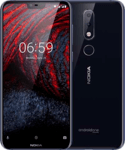
If you’re on the hunt for a mid-ranger, the Nokia 6.1 is worth your time. It’s known as one of Nokia’s best devices. We reviewed the device in-depth, comparing it with alternatives. So if you’re interested, keep reading.





Quick Navigation
The warranty and memory variant affects its final price. In case you didn’t know, company warranties are more expensive than store ones.
How do you feel about slippery phones? The Nokia 6.1 Plus is incredibly slippery, and it fell out of our hands several times. Then again, you’re probably not going to use it without a phone case, so this shouldn’t be an issue.
Thanks to its slipperiness, it makes sense that the back is glossy. The Nokia 6.1 Plus is one of the glossiest phones we’ve encountered. This is especially true for its black variant.
Speaking of colour variants, you can get the device in blue and white as well.
All of these colours come with a glass back. How else would it get so shiny? There’s Gorilla Glass 3 on the backs and fronts too. You get an aluminium frame around the corners, which is pretty scratch-resistant, but makes the phone even more soap-like.
How heavy is it? The Nokia device is 151 grams. By no means is it light, but it’s a feather compared to newer phones on the market. Heft may not seem important, but it makes a phone feel more premium.
We think that the Nokia 6.1 Plus is easy to use. Its dimensions are 147.2 x 71 x 8 mm, and its edges are pretty curved. This lets it fit snug into your palms. The cherry on top is the fact that its buttons are easy to reach, but more importantly, very responsive.
Being an older, budget model, it’s no surprise that the Nokia device comes with a headphone jack. And in case you’re wondering, there’s a microSD slot as well.
We’re fans of its display. It’s 5.8 inches, so it’s small, but not too small for our liking.
Colours are punchy too, coming with an IPS LCD screen. Is it the most vivid phone on the market? Definitely not. Samsung’s cheaper mid-rangers come with Super AMOLED panels that are more vibrant than the IPS LCD panel on the Nokia 6.1 Plus.
The phone is detailed. It comes with a 1080 x 2280 pixel screen resolution. You won’t notice blurriness with the naked eye.
Unfortunately, the Nokia device has some bezel action going on. This isn’t a surprise as it’s a mid-ranger from 2 years ago. So, what’s its screen-to-body ratio like? It’s 81.5%.
Remember how we mentioned it has gorilla glass 3 on its front? This makes its display durable.
In terms of brightness, the 6.1 Plus’ display is pretty good. Is it the best? No.
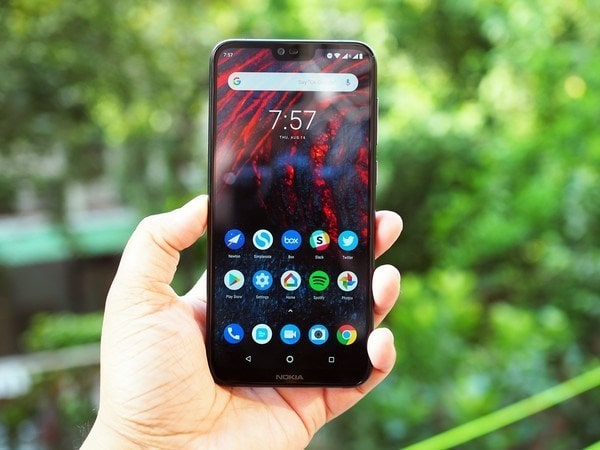
Nokia’s not a fan of large batteries. No surprise, you get a 3060 mAh unit with your purchase. Thankfully the 6.1 Plus’ screen isn’t the largest or the most powerful, letting the phone last a day.
If you’re wondering, yes, it comes with a fast charger. The 18 W fast charger takes a little over 2 hours to fully charge the device. Its charge time is pretty standard by today’s means.
If you’re wondering what kind of port you’ll be charging with, the Nokia 6.1 Plus comes with USB-C capabilities.
If you use the 6.1 Plus extensively, you’ll see it stutter. However, it’s pretty smooth for everyday tasks. You’re getting a Snapdragon 636 chipset, providing you with a snappy device. It holds up well even by today’s standards.
In terms of the memory variants, the Nokia 6.1 Plus comes with quite a few options. You can choose from 32 or 64 gigs of space, along with 4 or 6 gigs of RAM. We have to say, 4 gigs of RAM makes the 6.1 Plus extremely snappy. You can only imagine how responsive its 6-gig variant is.
Let’s talk about what Android version you get. Out of the box, you’re met with Android Oreo. Thankfully, the phone can be upgraded to Android 10.
The 6.1 Plus’ UI is stock Android, so Android purists will love this. As there’s barely any bloatware, this contributes to how easy the phone is to use.
There’s a dual camera set up on its rear. The primary camera is 16 MPs while the secondary camera is a 5 MP depth sensor.
We have to say, it produces some colour accurate shots. They’re pretty detailed too. The 6.1 Plus’ camera fairs well when compared to newer phones in its price range. It even focuses quickly.
There’s a dual sight mode for you to work with. It lets you use the front and back camera at the same time. However, it isn’t that useful.
Yes, we raved about its camera, but like most mid-rangers, all of this goes down the drain when the lights go out. Its dynamic range gets bad and shots become blurry in low light.
It also has a 16 MP front camera which is pretty good.
How great is the Nokia 6.1? Before we wrap things up, comparing the phone with a few alternatives seems like a good move. Let’s do it.
The 6.1 and the 6.1 Plus are pretty similar. The 6.1 is heavier though. You’re getting a device that’s 172 grams.
Its back is different. You aren’t met with gorilla glass 3, but an aluminium rear. It makes the phone less slippery, and we think it feels premium as well.
The aluminium also has a matte look to it, which we’re total fans of. This might not matter, however. You’re probably going to put a case on your Nokia 6.1.
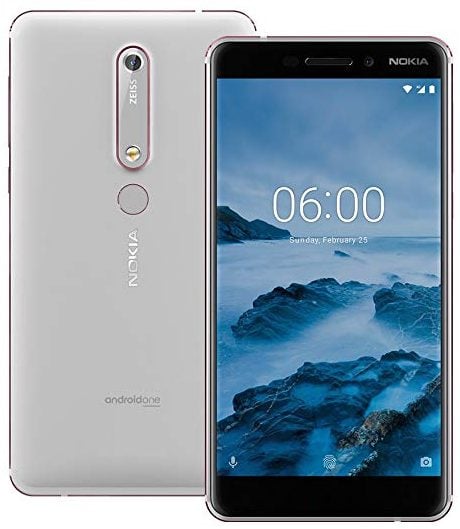
Unfortunately, its display is not that great. You’re getting a 5.5-inch device. In 2020, this doesn’t cut it. Its screen-to-body ratio doesn’t either. Its ratio is 73.2%, having some serious bezel action going on.
The fact that its display isn’t that sharp doesn’t help either. You get a 1080 x 1920 pixel screen resolution, which is noticeable.
And if you’re wondering, yes, you get an IPS LCD screen too.
Thankfully, you can upgrade the 6.1 to Android 10. Out of the box, it comes with Android 8 like its brother.
Being a Nokia device, its UI is stock Android. You already know how we feel about this.
The device is snappy, but not as much as the 6.1 Plus. You’re getting the inferior Snapdragon 630 chipset.
You’re probably wondering about the memory variants it comes with. There are 32 or 64 gigs of space at your disposal. Along with this, 3 or 4 GBs of RAM can be chosen. Once again, we’re pretty happy with the amount of RAM.
In case you’re not happy with 64 gigs of space, know that the 6.1 has a microSD slot as well.
What else? Well, the Nokia 6.1 Plus’ battery is larger. However, this doesn’t count as it’s only by 60 mAh. Considering that the 6.1 has a smaller screen, it easily lasts as long.
In terms of its charging capabilities, an 18 W fast charger is provided. Like its counterpart, the phone takes over 2 hours to fully charge.
Camera-wise, we don’t see much of a difference. You get a single, 16 MP camera on the device’s rear. In terms of the front camera, it’s a different story. You’ll see an 8 MP sensor.
Since it was released a year after the Nokia 6.1 Plus, it’s no surprise that the 7.2 looks better. It’s very Nokia Lumia-like, and we’re here for it.
It also comes with Gorilla Glass 3 on its rear. That being said, the phone’s not as slippery. It is super glossy though.
Being a larger phone, it’s harder to hold. The device is 6.3 inches, and we think that its edges are wide. This doesn’t mean that it’s uncomfortable to hold. They’re just curved.
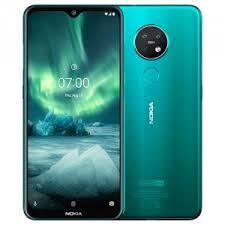
The 7.2 is 180 grams, which we’re here for.
We were not fans of its IPS LCD screen, however. Being so large, you want a screen that makes colours pop. Unfortunately, Nokia uses LCD panels for their mid-rangers, so we weren’t surprised.
It has a better screen-to-body ratio, but not by much. We think 0.9% of a difference isn’t noteworthy. What is noteworthy is the 7.2’s ability to play HDR10 content.
In case you’re wondering how detailed its screen is, it’s pretty much the same as the 6.1 Plus’. However, the phone is larger, so details are sharper. The screen resolution is 1080 x 2280 pixels, after all.
Out of the box, you’re getting Android 9. No surprise, the device is upgradeable to Android 10.
What’s also not a surprise is that the 7.2’s a better processor. It has the Snapdragon 660 inside it, leaving the 636 chip in the dust.
Did we mention the memory variants you get? You can choose from 64 or 128 gigs of space, along with 4 or 6 GBs of RAM. Once again, we’re happy with how much RAM we get. And if you guessed it, yes, the 7.2’s storage can be expanded with a microSD slot.
You see a small battery on the Nokia device. It’s 3500 mAh, which is larger than the 6.1 Plus’s, but the phone has a larger screen to feed. This means both phones last a day.
Surprisingly, you don’t get fast charging. Instead, it has a regular 10 W charger. What’s also surprising is the fact that both phones still take around the same time to go from 0-100%.
Camera-wise, the 7.2 outperforms the 6.1 Plus any day of the week. You’re getting a triple camera set up, with a 48 MP primary sensor.
The Redmi device is the heaviest phone we’ll be reviewing. It’s 190 grams and is a brick compared to its Nokia counterpart.
It’s still made from Gorilla glass, however. The back’s more resistant, coming with Gorilla Glass 5. We don’t think the phone’s as hard to use as the Nokia 7.2 but it is compared to the 6.1 Plus, however. The Redmi Note 8 is much larger, at 6.3 inches.
Unfortunately, it doesn’t come with a super glossy back. Instead, there’s an eye-catching gradient.
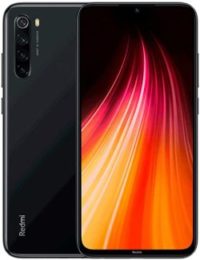
Being so large, the Redmi device provides a better viewing experience. This isn’t by much, though. The phone has an 81.7% screen-to-body ratio, which is barely better than the 6.1 Plus’. It also comes with the same IPS LCD screen we met before.
But how detailed is it? It’s better than its Nokia counterpart. You get a very noticeable 1080 x 2340 pixel resolution.
The Xiaomi phone’s screen is more durable too. It has a Gorilla Glass 5 display. Then again, you’re probably going to have tempered glass on, so this might not matter.
Processor-wise, the Note 8 comes with the Snapdragon 665. It’s much better than the 6.1 Plus’. It beats the 6.1 Plus’ chipset too.
It also comes with the newest Android variant out of the box. No, you’re not getting Android 10 straightaway, but Android 9. If you’re wondering, yes, the phone can be upgraded to Android 10.
You also get the most memory variants. For starters, 32, 64, and 128 gigs of space are at your disposal. Along with this, 3, 4, or 6 gigs of RAM are by your side.
Its battery is a giant when compared to 6.1 Plus’. It’s 4000 mAh, letting it last a day or more. Once again, we’re met with an 18 W fast charger, taking the Redmi Note 8 around 2 hours to fully charge.
Instead of a single camera set up, you’ll be getting a quadruple-camera on the Redmi device. The primary sensor is 48 MPs and you can only imagine how better it is.
In terms of its selfie camera, a 13 MP camera is by your side.
We think that the Nokia 6.1 is worth your time. For starters, it looks great, even though it’s super slippery. It comes with a small battery, but when compared to newer Nokia devices, it performs just as well.
In terms of its screen, it’s performance is similar to newer phones, but it doesn’t provide as immersive of an experience due to its size.
Its processor is great too, especially the camera.
But is it the best Nokia mid-ranger yet? It would’ve been in 2018, but newer Nokia devices outperform it.
Did you like our review? If so, don’t forget to check out our Facebook page. We regularly update it with informative content on phones.